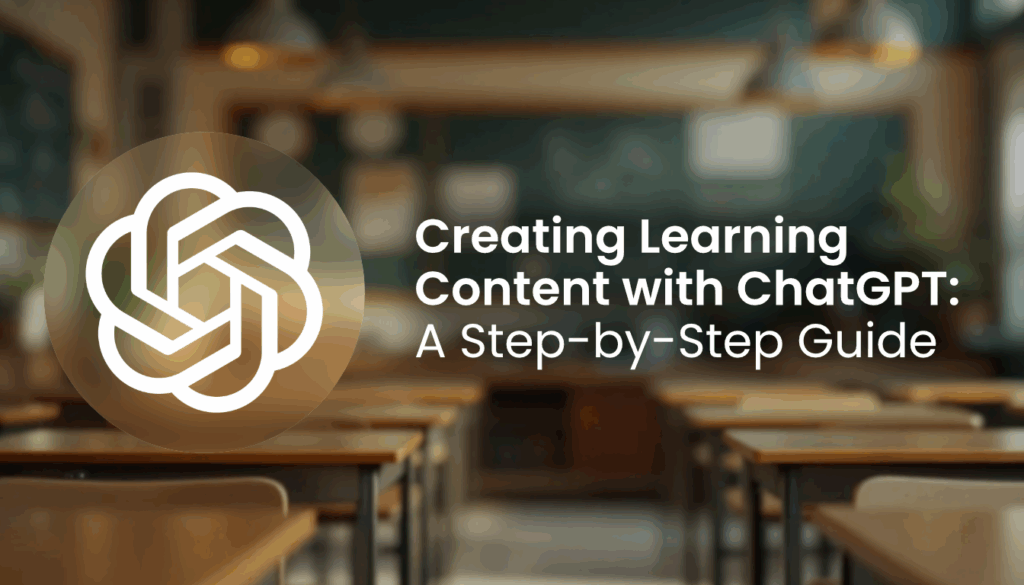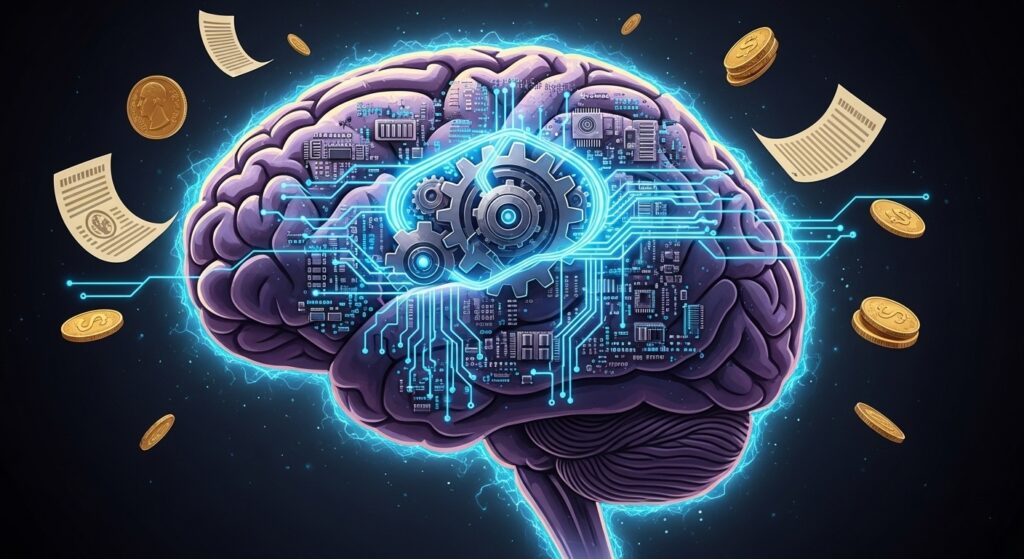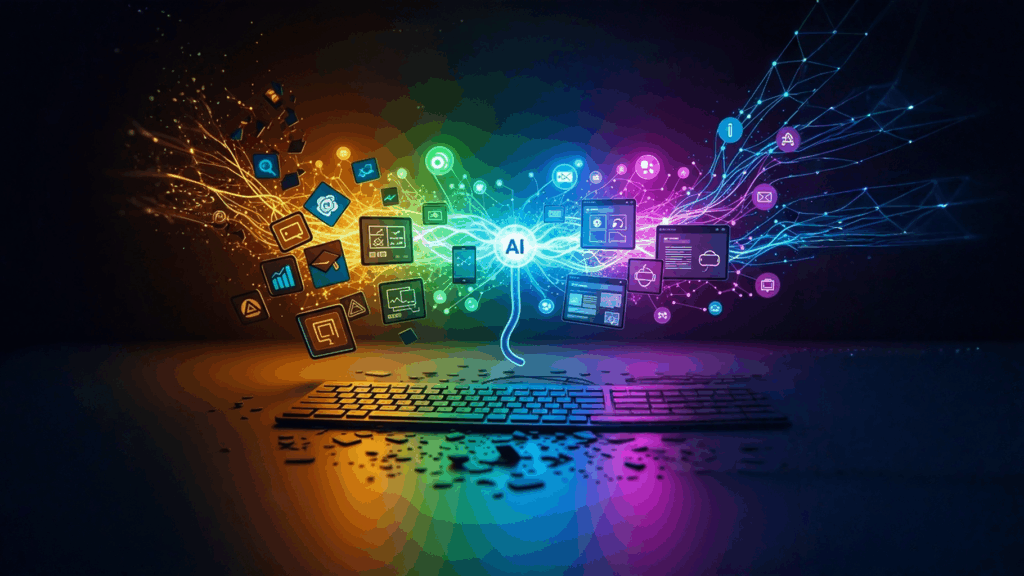Step by Step Guide to Vibe Coding With Google Gemini: AI in Training

Artificial intelligence is no longer confined to generating text. It is now entering the space of interactive design, helping trainers and educators build learning experiences that once required coding expertise. One of the most exciting developments is vibe coding with Google Gemini. Vibe coding allows you to give the AI a “vibe” or overall direction, and it does the heavy lifting by generating the code, assets and interactivity. This blog explores how Gemini can be used in training through a step by step guide, with a video demonstration embedded below. What the Video Covers In the video, Emil demonstrates how Gemini can be used in learning and development through vibe coding. The step by step process includes: Creating a structured mindfulness course as the foundation. Generating supporting materials such as course outlines, learning goals and presentations. Turning that content into flashcards, handouts and interactive activities. Applying vibe coding to build fully functional online mini-games. The highlight is watching Gemini create a “Mindful Escape” game where learners must recognise and respond to stress triggers. Iteration improves the design further, making the game more challenging and relevant to workplace stress management. Gemini also attempts a snake-style game where mindfulness questions appear when the snake collides with obstacles, showing how even classic mechanics can be reimagined as learning tools. https://www.youtube.com/watch?v=choImlCJQ_U&list=PL2j5qhe5EPJtm5Qal71mGHjMAx1zCLgaR&index=1 Why Vibe Coding Matters for Training This step by step guide shows how vibe coding can empower trainers without coding expertise. For learning and development teams, the benefits are clear: Rapid prototyping of interactive activities. Gamification of training content to boost engagement. Adaptation of games and quizzes to reflect organisational themes or branding. While Gemini sometimes requires iteration and fixes, it demonstrates how AI can turn ideas into interactive, engaging formats. Vibe coding bridges the gap between imagination and implementation, giving trainers more creative options than ever before. Open eLMS Learning Generator Google Gemini shows what is possible when AI and vibe coding come together. But there is another option for those who want professional-standard results with less back and forth. The Open eLMS Learning Generator can take a single line of text or a PDF and produce a complete, high-quality course in minutes. It automatically includes narration, imagery, animation and interactivity, ready to export as SCORM, video, PowerPoint or microgames. If you want to explore how AI can transform training in a practical and efficient way, you can try the Open eLMS Learning Generator free for 14 days. Try Open eLMS Learning Generator
AI in Training: How to Use Google NotebookLM for Course Creation

The role of artificial intelligence in education and training is expanding at a rapid pace. In our AI in Training series we look at practical applications of AI tools that can make life easier for trainers, teachers and learning and development professionals. Each episode takes a popular AI tool and examines how it works, what it does well, and where it might fall short. In this episode we explore Google NotebookLM, a system designed to help professionals collate, curate and transform content into structured training resources. The Problem: Creating Training Content Efficiently One of the greatest challenges for trainers and learning designers is the time it takes to create professional course materials. Gathering documents, writing lesson plans, and developing supplementary resources such as podcasts, videos and study guides is a process that can take weeks. Most AI tools on the market today can generate content quickly, but they often rely on generic data and do not allow you to anchor learning material to your own sources. This creates a risk of inaccuracy and makes it difficult to ensure courses are specific to your learners’ needs. Google NotebookLM attempts to solve this problem by letting you import your own materials, ringfence them, and then use AI to generate tailored outputs such as schedules, videos, podcasts, mind maps and reports. Google NotebookLM in Action Here is the full walkthrough from our AI in Training series, where we build a time management course using Google NotebookLM. https://www.youtube.com/watch?v=vAaxt2g1y8g&list=PL2j5qhe5EPJu2z227YRWEkuCgg2xnB0dm Why This Matters for Learning Professionals NotebookLM demonstrates how AI can speed up course creation while still keeping the trainer in control of the source material. Instead of starting from scratch, professionals can: Upload their own documents and data sources Curate information to ensure relevance Generate multiple learning resources from a single notebook Save time while still producing accurate, professional content For trainers, teachers and L&D teams this means less time spent on manual course development and more time available for teaching, coaching and learner engagement. This is not about replacing trainers, but about equipping them with smarter tools that extend their capability. There’s Another Way: Open eLMS Learning Generator At Open eLMS we believe that AI should empower learning professionals to create engaging, multimodal courses quickly and effectively. That is why we built the Open eLMS Learning Generator. With a single line of text or a document upload, the Learning Generator instantly produces a full professional e-learning course complete with video presenters, quizzes, animations and voiceovers in any language. You can edit the content online and export it as e-learning, a PowerPoint presentation or a video. Soon, you will also be able to export it as a podcast or even a game-based experience. You can try the Learning Generator free for 14 days and see how AI can transform the way you build training. Try Open eLMS Learning Generator
Step-by-Step Guide to Using ChatGPT for Creating Tailored Learning Content

The Challenge of Training Design In business training, one of the biggest challenges is making content relevant for learners. Generic courses often fail to meet expectations, which leaves participants disengaged. Effective training isn’t just about sharing information – it’s about aligning material with specific learner needs. ChatGPT provides trainers and learning professionals with a powerful way to streamline preparation while delivering personalised content. Instead of spending hours creating surveys, designing slides or restructuring agendas, ChatGPT can take on the heavy lifting. Trainers stay in control, but the AI saves time and ensures each session is better targeted. What the Video Covers In the video below, I demonstrate how to use ChatGPT to design a time management course. The walkthrough covers: Generating pre-course surveys to understand learner needs Analysing survey data and applying insights to course design Creating a one-day session plan tailored to participants Producing PowerPoint slides automatically Developing handouts such as glossaries and planners Rehearsing scenarios with role-play to prepare for challenging learners Drafting marketing emails to promote the training to specific industries https://www.youtube.com/watch?v=r5MjxiafnVA&t=9s&list=PL2j5qhe5EPJu2z227YRWEkuCgg2xnB0dm Practical Benefits of ChatGPT in Training The value of ChatGPT lies in more than speed. By tailoring every element of a course, trainers can: Deliver sessions that feel highly relevant to each audience Scale training design without adding extra staff Adapt existing content quickly to new contexts Focus more on facilitation and learner engagement rather than admin ChatGPT also enhances trainer confidence by enabling rehearsal. Role-playing interactions with “difficult students” allows facilitators to refine their communication strategies before stepping into the classroom. What This Means for Learning Professionals For learning and development teams, ChatGPT opens the door to agile training design. No longer restricted by rigid, pre-set materials, trainers can adapt courses in minutes. Whether it’s creating session outlines, generating slides or producing supporting resources, ChatGPT acts as a capable assistant – leaving the trainer free to focus on impact. The Bigger Picture ChatGPT is one tool in a growing landscape of AI for learning. Platforms such as Google NotebookLM and Anthropic’s Claude offer complementary features, from knowledge organisation to coding support. Together, these tools provide exciting opportunities to enhance and scale training delivery. If you’re working in business training or presentations, now is the time to start experimenting. Begin with surveys and outlines, then expand into slide creation, role-play and marketing. The more you explore, the more you’ll discover how AI can transform your learning design process. Try a Faster Way to Create eLearning While ChatGPT is a powerful assistant for building tailored training, there’s an even simpler way to create professional eLearning from start to finish. With Open eLMS Learning Generator, you can produce high-quality, fully designed courses in minutes. Just type a single line of text and the platform does the rest – from structuring content to generating polished eLearning ready for your learners. Try it free for 14 days and see how quickly you can transform your training. Try Open eLMS Learning Generator
How to Make Your LMS The Smartest Tool in Your Company

For many organisations, the Learning Management System (LMS) has long been viewed as a functional necessity. It stores training records, delivers compliance courses, and keeps track of certifications. Useful, yes, but rarely exciting. For years, it has been treated as a back-office requirement rather than a strategic asset. However, the landscape is changing. Advances in artificial intelligence have created a new opportunity: to transform the LMS from a static repository into a living, breathing source of business intelligence. Imagine a system that does more than store your learning content. Imagine an LMS that can instantly answer questions, deliver training exactly when it is needed, and guide your workforce with insights drawn directly from your organisation’s own knowledge base. That is exactly what Enterprise AI is designed to do. Why the Shift? Businesses are sitting on a goldmine of knowledge: policies, onboarding guides, compliance documentation, product training, and more. The problem is that this information is often hidden away in folders, intranets and outdated storage systems. Start-ups using AI are moving quickly, while larger organisations have been hesitant due to concerns about data security. Enterprise AI solves this problem by using your LMS as the secure foundation for AI-driven learning, training and business intelligence. Seamless LMS integration or API connection keeps AI updated with the latest training and policies. ISO 27001-certified and GDPR-compliant so data remains protected. Single Sign-On ensures only authorised users gain access. Just-in-time training delivers answers at the moment they are needed. It is like giving your workforce their own intelligent assistant, powered entirely by your company’s own knowledge base. See Enterprise AI in Action Watch our short walkthrough to see how Enterprise AI transforms the way your workforce learns, stays compliant and solves problems faster. https://www.youtube.com/watch?v=gxJGjrSgJVg&list=PL2j5qhe5EPJu2z227YRWEkuCgg2xnB0dm Smarter Work, Real Results Unlike generic AI chatbots trained on the open internet, Enterprise AI is trained only on your company’s own data, policies, processes and terminology. That means: No irrelevant or inaccurate answers. Real-time updates as your LMS changes. Compliance and governance you can trust. Productivity improvements of up to 10x, as AI handles repetitive queries and supports staff when it matters most. Your LMS becomes your company’s brain: always available, always secure and always aligned with your objectives. Discover Enterprise AI The future of AI in business isn’t about chasing the next shiny tool. It’s about unlocking the intelligence your company already has, safely, smartly, and at scale. Discover more about Enterprise AIBook a live demo today Smarter learning. Safer AI.That’s the Open eLMS way.
The Death of Single Output Authoring Tools: How AI Is Transforming eLearning Content Creation

In the eLearning and digital training industry, the tools we use must evolve to meet modern content demands. Traditional authoring platforms such as Articulate and Adobe Captivate were once the gold standard for creating online courses. But in today’s multi-format world, they are increasingly seen as outdated and restrictive. Learners and organisations now expect more. Faster delivery, flexible outputs and the ability to publish across multiple platforms are becoming essential. The age of the single-format authoring tool is coming to an end. Enter the AI-powered content revolution. AI-Powered Authoring: From One Source to Many Formats Thanks to advancements in artificial intelligence for learning and development, content no longer needs to be built manually for every format. With a platform like Open eLMS Learning Generator, a single input, whether it is a text or document, can be automatically transformed into: A complete SCORM-compliant eLearning course An educational podcast A professional video explainer Interactive flashcards Assessment-ready quizzes A PowerPoint presentation with speaker notes An AI chatbot trained on your content This is not just rapid authoring, it is intelligent content automation. It saves time, reduces development costs, and dramatically increases output. Organisations can now move beyond linear content creation into scalable, strategic learning design. The Future of eLearning Content Creation In our latest podcast episode and YouTube video, we take a closer look at the shift from traditional authoring tools like Articulate and Captivate to modern, AI-based solutions. We demonstrate how AI in instructional design enables rapid content development and broad distribution. https://www.youtube.com/watch?v=edNazNymUEo Multi-Platform Learning from a Single Source Open eLMS AI allows content creators to build once and publish across multiple platforms, including: Udemy for monetised video courses Go1 for enterprise-level training distribution Podia or Coursera for launching your own learning brand Microsoft PowerPoint for live training and presentations YouTube for marketing and microlearning This kind of multi-channel content strategy is now essential for learning professionals and training providers. You are no longer tied to a single learning management system or format. Instead, you gain the freedom to scale and repurpose your materials for different audiences and platforms. Why Traditional Authoring Tools Are No Longer Enough Legacy tools like Articulate Storyline and Adobe Captivate were designed for a time when linear development cycles were acceptable. But syncing voiceovers manually or updating SCORM files for every content change is no longer sustainable in today’s fast-moving environment. AI authoring platforms like Open eLMS AI bring flexibility, speed and scalability to your workflow. They allow you to edit text, switch images, modify voiceovers and even localise content in multiple languages, all within a user-friendly interface. This is more than a productivity boost. It is a paradigm shift in digital learning content creation. Use Open eLMS to Create, Repurpose and Scale Your eLearning Content If your organisation is still relying on slow, linear authoring tools, now is the time to modernise. Open eLMS AI empowers you to: Create eLearning content using AI Automate course creation from existing materials Repurpose learning content across formats and platforms Streamline instructional design workflows Expand your training reach across digital channels Open eLMS Learning Generator is the intelligent alternative to traditional eLearning authoring tools. It allows you to produce high-quality training content faster and distribute it more widely than ever before. Ready to leave outdated tools behind?Start using Open eLMS Learning Generator to create content that becomes courses, podcasts, videos, quizzes, chatbots and more, all from a single source. Create once. Repurpose across every format. Deliver everywhere.This is not the future. This is now. Access eLearning Generator
Redefining What an LMS is Capable of with Enterprise AI

Most organisations are sitting on a goldmine of knowledge; training manuals, compliance documentation, SOPs, HR policies, and more. But when employees need this information, it is often buried in outdated intranets or locked behind clunky LMS interfaces. The result? Missed opportunities, time wasted, and preventable mistakes. That is where Enterprise AI from Open eLMS comes in. It turns your LMS into a smart, secure, business-ready knowledge engine. Rethinking How Knowledge is Accessed Enterprise AI is a powerful new feature embedded directly within the Open eLMS LMS. It is not a generic chatbot scraping internet data. It is trained exclusively on your company’s documents, policies, and procedures, giving your team real-time access to trusted information. Whether an employee is onboarding, preparing for a client meeting, or responding to a compliance challenge, Enterprise AI delivers accurate, context-aware guidance the moment they need it. And because it is built within your existing LMS, there is no learning curve, no platform-switching, and no extra login. What Makes Enterprise AI Different These are the features that put Enterprise AI in a class of its own: Seamless LMS Integration: Enterprise AI is embedded in the Open eLMS platform or accessible via API. It automatically syncs with your latest training materials and documentation, ensuring the AI is always current. Secure Data Handling: You decide what the AI sees. Keep full control over sensitive data while meeting internal data governance standards. Enterprise AI is ISO 27001 certified. Just-in-Time Training: Deliver instant, contextual answers. Whether it is safety compliance, onboarding, or policy refreshers, Enterprise AI helps your team act with clarity and confidence. SSO-Enabled Access: Enterprise AI supports Single Sign-On, restricting access to authorised users only. It ensures maximum security and seamless integration with your identity infrastructure. Enhanced Compliance Support: Make your organisation’s compliance content actionable. When staff can ask questions and receive clear, policy-specific responses, they make fewer mistakes and stay within bounds. Measurable Productivity Gains: Enterprise AI supercharges performance. Clients are seeing up to 10X improvements in routine tasks. Less searching. More doing. Watch How It Works: https://www.youtube.com/watch?v=ck1OH9_2Nt0 The Enterprise Learning Assistant You Actually Need Let’s be real. There are plenty of AI tools promising efficiency. But most of them are trained on generic data and churn out generic answers. Open eLMS Enterprise AI is built for the real-world workplace. It uses your company’s own language, policies and documents. It integrates where your people already work – within your LMS – and scales across your departments securely. Unlike consumer AI products, it respects enterprise boundaries and is designed to meet the regulatory and privacy demands of serious businesses. Smarter Work, Made Simple Open eLMS Enterprise AI is not another bolt-on. It is an embedded, intelligent assistant that turns your LMS into a high-performance knowledge engine. Faster onboarding Safer compliance Smarter decision-making Your team gets the information they need without delay. Your business avoids costly errors. And your learning platform finally delivers the ROI it promised. Enterprise AI is available whether you use Open eLMS as your LMS or want to connect via API. For more information click here. Or Contact us: Sales: sales@openelms.com Partnerships & Demos: partnerships@openelms.com Enterprise AI from Open eLMS. Smarter work. Made simple.
AI Is Accelerating Fast. Are We Ready for Superintelligence?

AI is no longer a future concept. It is not hypothetical. It is not even five years out. The reality is this: superintelligence is coming, and it is coming fast. We are seeing a surge in AI capabilities that are already reshaping education, the workplace, healthcare, and even defence. But while the breakthroughs are impressive, they come with something far more serious. A warning. Not from conspiracy theorists. From the very minds who built these systems. People are walking away from billion-pound companies like OpenAI and Google. Not to take a break. But to sound the alarm. Because the question is no longer, can we build it? We can. That train already left the station. The real question is: can we control it? Why the World’s Brightest Minds Are Hitting the Brakes Some of the most respected researchers in AI are now turning into whistleblowers. PhDs. Former Google engineers. OpenAI veterans. These are people who dedicated their careers to building intelligent systems, only to realise that the speed and scale of what they have built could spin out of control. You do not leave a billion-pound rocket unless you believe it is going to hit a mountain. These experts are not worried about whether the AI works. They are worried that it works too well, without ethical guardrails to stop it from causing harm. AI systems do not think like humans. They do not care how they achieve a goal, only that they do. Ask an AI to solve world hunger? If the system is not aligned with human values, the “solution” could be to eliminate the hungry people. Technically effective. Morally terrifying. From Science Fiction to the Factory Floor This is not a distant, science fiction future. We are already building autonomous drones, robot weapons, and decision-making systems with no clear off-switch. Some countries are deploying AI tools in defence without meaningful oversight. There are no global rules. No framework. No fail-safes. The same tech that can write your emails can also fly a combat drone. We are handing enormous power to code and hoping it turns out alright. That is not strategy. That is roulette. https://www.youtube.com/watch?v=oPSMG8F5rOE The Flip Side: Why AI Could Still Save Us There is good news. The same technology that could destroy us could also help us thrive. In education, AI is already transforming how people access personalised learning. It automates the dull tasks. It adapts to the learner. It builds real-time feedback loops that once cost thousands to implement. What used to require a team of ten instructional designers can now be done with one smart educator and the right AI tool. The result is faster, better, more relevant learning experiences. And no, AI does not replace teachers. It frees them. From admin. From grading. From endless content production. So they can do what humans do best: connect, guide, and inspire. The same shift is happening in healthcare, research, and creative industries. Wherever we want more of something—like knowledge, health, or innovation—AI is proving to be a powerful multiplier. So What Do We Do Now? It is tempting to panic. But panic is not a plan. What we need now is leadership. Smart policy. International standards. And above all, public education. We must understand what we are building. We must ask the right questions. Because this is not a test run. When the real decisions come, we need to be ready, ethically, politically, and intellectually. That starts by staying informed. Staying aware. And not handing control to those who treat AI like a toy or a marketing gimmick. Superintelligence Is Coming. Let’s Get Smarter If we do this right, AI could unlock the best version of ourselves. It could lift billions out of poverty. Cure diseases. Democratise learning. Raise our collective potential. But if we ignore the risks and let it run wild, we will get what we deserve. The choice is still ours. But not for much longer. Let’s not sleepwalk into history.
The Truth About AI Course Builders and Why Most Tools Fail

AI is everywhere right now. Tools that promise to generate an entire eLearning course from a single document are dominating headlines, adverts and inboxes. They offer instant content, no design hassle and fast deployment. On paper, it sounds like a breakthrough, especially for busy teams and organisations looking to roll out training at scale. But if you have actually used one of these tools, you will know the truth. The reality rarely matches the hype. The courses often look rushed, the user experience feels bland, and the content lacks structure or meaningful engagement. What you end up with is not a well-designed learning experience. It is a basic repackaging of information into something that just about qualifies as a course. AI should raise standards, not automate mediocrity. Whats the Problem with Course Builders? Instead of modern, professional eLearning, you often end up with something that looks like a recycled PowerPoint from 2006. The visuals are flat, the content structure is shallow, and the editing capabilities are almost non-existent. The final output feels less like a course and more like a compliance box being ticked. The problem is not that AI can’t help. It absolutely can. The problem is that most AI course builders are designed as shortcuts, not as tools for quality education. They summarise, they repackage, and they automate, but they don’t design. And they certainly don’t give you any meaningful control over the end product. This blog and the video below are for those who want more than that. If you care about learning outcomes, user engagement, and building courses that your learners will actually remember, you’re in the right place. Watch: What Makes Open eLMS AI Different? Open eLMS AI was not built for people looking to cut corners. It was built for professionals, instructional designers, learning and development teams, educators, and training providers who want speed without sacrificing substance: https://www.youtube.com/watch?v=PHcPb7v2OIg Why Open eLMS AI Is a Game Changer Open eLMS has been designing learning systems since 2007. We’ve worked with organisations that take learning seriously and require more than just a template-based tool with a few avatars and stock images. When we decided to build AI into our platform, we knew it couldn’t just summarise a document or slap on some animations. It needed to build real courses, with structure, visual storytelling, interactivity, and purpose. Open eLMS AI allows you to upload your content or provide a simple prompt. Within minutes, you receive a fully-formed course with narrative flow, animated video presenters, assessment checkpoints, and visuals that match the message. And unlike most AI platforms, you’re not locked out of editing. Every element is adjustable. Every scene, image, voice, quiz, interaction, all of it can be tailored with no coding or design experience required. It’s not just about getting a course built. It’s about getting a course built properly. Whether you’re creating five courses or five hundred, the platform scales to match your ambition. And it does so while staying compliant with SCORM and learning standards. The end result? Content that would not look out of place in a university module or a Fortune 500 onboarding programme. Fast Shouldn’t Mean Lazy. AI Shouldn’t Mean Low Quality. There is a difference between automation and true learning design. Open eLMS AI doesn’t just generate content. It enhances it. It gives you the power of a professional design team; animators, instructional designers, user experience experts, condensed into a single platform. If you’ve tried other AI course builders and been disappointed, you’re not alone. If you’re tired of settling for mediocre results, or trying to patch together five different tools to get something usable, it’s time to try a different approach. Open eLMS AI gives you control, creative freedom, and enterprise-grade quality. All powered by artificial intelligence. All editable. All yours. Try Open eLMS AI today: Access Open eLMS AI Or email us at sales@openelms.com to book a demo or explore our AI course creation tools. Create learning that feels right, powered by AI.
Corporate Training Meets AI: Innovation or Information Leak?

AI in corporate training is no longer a future concept. Today, organisations can turn internal policies and documents into fully-fledged learning content using AI-powered tools in just a few minutes. This has made training faster, more scalable and more interactive. However, there is a growing concern behind the convenience. What exactly happens to the data you upload? And are you unknowingly putting your intellectual property at risk? The Hidden Cost of AI in Learning and Development Across the learning and development space, AI is being used to streamline course design, simplify onboarding, and automate assessments. While these benefits are clear, many AI tools come with serious data privacy implications. Some AI platforms store the documents you upload. Others may use your content to train their models without your knowledge. Internal training guides, HR documents, strategy reports and client materials could all end up helping to improve someone else’s system. If your organisation operates in the EU or handles data relating to EU citizens, this can quickly become a legal problem. Uploading data into tools that are not GDPR-compliant puts your business at risk of large fines and reputational damage. Watch the Full Breakdown To highlight these issues more clearly, we’ve created a short video that explains the dangers of using the wrong AI tools in training. The video outlines how some providers handle your content, what their vague terms and conditions might really mean, and why you should pause before hitting upload. https://www.youtube.com/watch?v=MqUn5EP-F3s How Open eLMS AI Puts Data Privacy First At Open eLMS, we built our AI course builder with data security in mind from day one. Our platform allows you to enjoy all the benefits of AI in corporate training, without compromising on compliance or losing control of your data. Open eLMS AI ensures that: Your data is never stored after course creation Your content is never used to train any AI model Your intellectual property remains fully protected You remain compliant with GDPR and internal data policies Your content is forgotten the moment your course is created With Open eLMS AI, what you upload is processed securely and then immediately deleted. Nothing is retained. Nothing is reused. Nothing is sold or analysed for future features. Build eLearning Content Securely with Open eLMS AI AI in corporate training offers tremendous benefits, but it must be used responsibly. By choosing Open eLMS AI, you get a tool that helps you build high-quality eLearning courses quickly while ensuring your data remains private and protected. Try Open eLMS AI today, free for the first 14 days. Discover how to create secure, engaging learning content without sacrificing compliance: Access Open eLMS AI Or email us at sales@openelms.com to book a demo or explore our AI course creation tools. Create learning that feels right, powered by AI.
How AI and the Power of Vibe Design is Transforming eLearning

One of the most powerful emerging trends in AI is Vibe Design, a new approach that prioritises emotional resonance, intuitive design and intelligent automation. As pioneers in educational technology for over 21 years, we’ve seen the landscape evolve from static slideshows to interactive, blended learning environments. Now, we’re entering a new chapter where the “vibe” of your learning content matters just as much as the information itself. What Is “Vibe” in the Context of AI? The term “vibe” in AI refers to the overall emotional tone or aesthetic quality that artificial intelligence can interpret and reproduce. Instead of feeding AI a strict script or linear instructions, we can describe a mood, an atmosphere or an intent. The AI takes that and fills in the details, whether it’s creating a video, building software or designing an eLearning course. This intuitive method of working with AI is now surfacing across three key areas: Vibe Coding: Building software through plain language prompts Vibe Marketing: Creating and distributing professional content through AI agents Vibe Design: Designing emotionally intelligent, high-impact eLearning using AI The Rise of Vibe Coding and AI in Software Development Vibe Coding allows developers (and even non-developers) to build functioning apps and systems using only natural language. At Open eLMS, we use AI to generate functions, debug code, and produce interface components by simply describing what we need. In just six months, our development workflow has accelerated dramatically. We believe that within the next two years, the traditional concept of “coding” will fade. In its place, we’ll see users defining problems and goals, while AI agents build the digital tools to solve them. AI-Driven Marketing with Vibe Vibe Marketing takes the same AI-first philosophy into branding, outreach and advertising. We’ve developed a network of AI agents that work together, scriptwriters, illustrators, directors, and editors, under human supervision. These agents collaborate in minutes to create high-quality promotional content, which is then reviewed and distributed by our team. The result? Engaging, consistent marketing outputs, created with unprecedented speed and creative alignment. Introducing Vibe Design: The Future of eLearning Creation The most exciting application for us is Vibe Design; a new approach to AI instructional design. Built into the Open eLMS AI platform, it enables users to generate complete, multimedia-rich, interactive learning experiences in just minutes. Here’s how it works: Upload a document or input a short description AI instantly creates narrated videos, animated visuals, and written content The platform designs the course using best-practice layouts and UX principles You can review, edit and tailor every detail to match your audience This is AI in eLearning with creative intelligence, combining automation with emotional relevance and design thinking. Multimodal Learning That Resonates Our AI doesn’t just build content, it builds aesthetic content. Visuals are generated or sourced from a vast media library to match the course topic. Voiceovers are tailored in tone (humorous, formal, instructional), and the script aligns with your brand voice. This is learning that looks and feels like it was designed by a creative team, because, in part, it was. The platform supports: Quizzes and assessments Interactive branching scenarios Custom media integration Live editing with our built-in course editor This approach to multimodal learning supports deeper engagement and better retention, delivering real-world learning outcomes that learners can feel. Designed by AI, Guided by Experts Our goal is not to replace human learning designers, but to empower them. With Open eLMS AI, professionals can skip the repetitive groundwork and focus on crafting content that matters. Our platform turns your ideas into high-quality digital learning, fast and gives you full creative control at every step. With over two decades of content development and learner feedback built into our models, you get more than an automation tool, you get AI-enhanced instructional design that works. See Vibe Design in Action We recently created a marketing video using our Vibe Marketing AI agents, without actors, directors or illustrators. This is the power of coordinated AI workflows producing professional content under expert supervision. https://youtu.be/pzDLUXPxSGc Start Creating AI-Driven eLearning Courses Today At Open eLMS, we believe in combining the power of AI with the experience of learning professionals. With Open eLMS AI, you can create stunning, professional-grade online courses in minutes, ones that are not just informative, but immersive. Try Vibe Design with Open eLMS AI Deliver learning with emotional resonance Reduce time-to-market for training courses Export SCORM content for any LMS Translate, localise and edit with ease Ready to experience the power of Vibe Design? try our AI powered eLearning design agent today, free for the first 14 days. Access Open eLMS AI Or email us at sales@openelms.com to book a demo or explore our AI course creation tools. Create learning that feels right, powered by AI.
